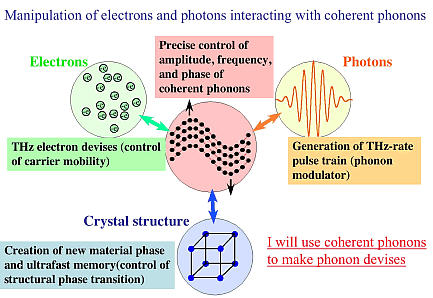@Under the irradiation of the femtosecond laser pulses, coherent oscillations
of Raman active phonons can be excited through electronic excitation via real
or virtual intermediate states, which are characterized by displacive and impulsive
excitations of coherent phonons, respectively. There have been extensive studies
on the generation of coherent phonons and on the dephasing dynamics of coherent
phonons, in semimetals, semiconductors, and superconductors in the past decade.
Recently, it has been revealed that coherent phonons in solids can be optically
controlled by the irradiation of terahertz-rate pulse trains whose time periods
match to the oscillation period of the coherent phonons. Thus the coherent phonon
has been the focus of much attention because of its wide applications as well
as its fundamental interest from the viewpoint of lattice dynamics.
@As the characteristic of the coherent phonon, the reflectance change of 10-2 to 10-S is
induced by coherent oscillations at a sample surface. Therefore, by use of this
reflectance changes, amplitude modulation of the light can be possible. In addition,
phonons in solids are closely related to structural phase transition. In particular,
in displacement-type ferroelectrics there is so-called soft mode whose frequency
becomes extremely low near the critical point, and it has been accepted that
phase transitions are caused by displacement of this soft mode. Therefore, operation
of structure phase transition is expected if light pulses can control the amplitude
of the coherent soft mode.
@In the present study, I will try to manipulate the phase transitions in solids,
the mobility of electrons, and the properties of photons, which are interacting
with coherent phonons, by precisely controlling the amplitude, the frequency,
and the phase of coherent phonons. Furthermore, in the near future, I would propose
completely new phonon devises by using controllability of the coherent phonons.

References:
• M. Hase , K. Ishioka, J. Demsar, K. Ushida, M. Kitajima,h Ultrafast
dynamics of coherent optical phonons and nonequilibrium electrons in transition
metalsh, Phys. Rev. B. Vol. 71 , 184301 (2005).
• M. Hase , M. Kitajima, A. M. Constantinescu and H. Petek,hThe birth
of quasiparticles in Si observed in time-frequency spaceh, Nature ,
Vol. 426 , pp.51-54 (2003).
• M. Hase , M. Kitajima, S. Nakashima and K. Mizoguchi,hForcibly driven
coherent soft phonons in GeTe with intense THz-rate pump fieldsh, Appl. Phys.
Lett., Vol. 83 , No. 24, pp.4921 (2003).
• M. Hase , M. Kitajima, S. Nakashima, and K. Mizoguchi,hDynamics
of coherent anharmonic phonons in bismuth using high density photoexcitationh, Phys.
Rev. Lett., Vol. 88, No. 6, pp. 067401 (2002). |

